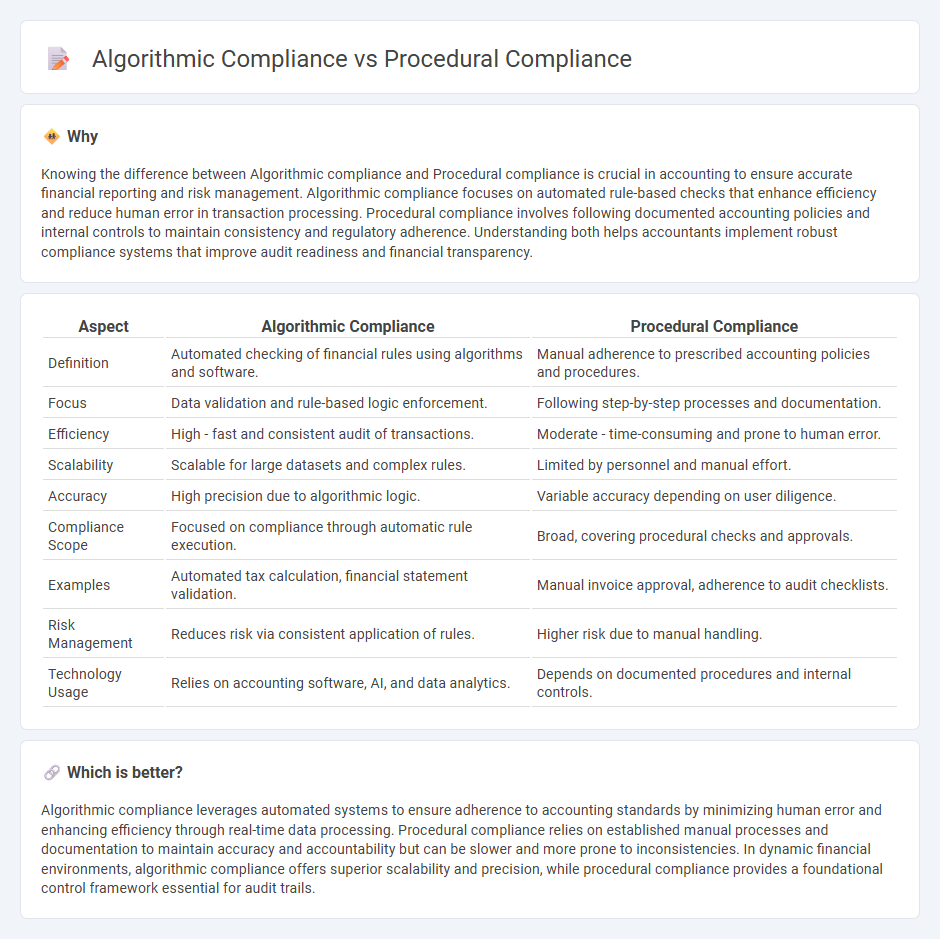
Algorithmic compliance leverages automated systems and artificial intelligence to ensure adherence to regulatory standards with precision and real-time monitoring. Procedural compliance relies on established manual processes and documented workflows to maintain conformity with legal and organizational requirements. Discover how these approaches impact efficiency and accuracy in modern accounting practices.
Why it is important
Knowing the difference between Algorithmic compliance and Procedural compliance is crucial in accounting to ensure accurate financial reporting and risk management. Algorithmic compliance focuses on automated rule-based checks that enhance efficiency and reduce human error in transaction processing. Procedural compliance involves following documented accounting policies and internal controls to maintain consistency and regulatory adherence. Understanding both helps accountants implement robust compliance systems that improve audit readiness and financial transparency.
Comparison Table
| Aspect | Algorithmic Compliance | Procedural Compliance |
|---|---|---|
| Definition | Automated checking of financial rules using algorithms and software. | Manual adherence to prescribed accounting policies and procedures. |
| Focus | Data validation and rule-based logic enforcement. | Following step-by-step processes and documentation. |
| Efficiency | High - fast and consistent audit of transactions. | Moderate - time-consuming and prone to human error. |
| Scalability | Scalable for large datasets and complex rules. | Limited by personnel and manual effort. |
| Accuracy | High precision due to algorithmic logic. | Variable accuracy depending on user diligence. |
| Compliance Scope | Focused on compliance through automatic rule execution. | Broad, covering procedural checks and approvals. |
| Examples | Automated tax calculation, financial statement validation. | Manual invoice approval, adherence to audit checklists. |
| Risk Management | Reduces risk via consistent application of rules. | Higher risk due to manual handling. |
| Technology Usage | Relies on accounting software, AI, and data analytics. | Depends on documented procedures and internal controls. |
Which is better?
Algorithmic compliance leverages automated systems to ensure adherence to accounting standards by minimizing human error and enhancing efficiency through real-time data processing. Procedural compliance relies on established manual processes and documentation to maintain accuracy and accountability but can be slower and more prone to inconsistencies. In dynamic financial environments, algorithmic compliance offers superior scalability and precision, while procedural compliance provides a foundational control framework essential for audit trails.
Connection
Algorithmic compliance and procedural compliance intersect in accounting through the automation of regulatory adherence and standardized processes. Algorithmic compliance leverages software algorithms to ensure transactions and reporting follow legal and financial regulations, while procedural compliance involves adhering to defined internal controls and documentation standards. Integrating both enhances accuracy, reduces risk of errors, and ensures consistent enforcement of accounting rules and policies across financial operations.
Key Terms
Internal Controls
Procedural compliance emphasizes adherence to established policies, processes, and documentation to ensure internal controls operate effectively, while algorithmic compliance leverages automated systems and algorithms to monitor and enforce regulatory requirements in real-time. Internal controls benefit from combining procedural rigor with algorithmic precision to enhance fraud detection, accuracy, and accountability within organizations. Explore the evolving landscape of procedural and algorithmic compliance to optimize your internal control frameworks.
Audit Trail
Procedural compliance emphasizes adherence to established processes and documentation, ensuring audit trails are complete and transparent for regulatory review. Algorithmic compliance involves validating automated systems and their decision-making algorithms, requiring robust logging mechanisms to capture each computational step for traceability. Explore in-depth how audit trails enhance both procedural and algorithmic compliance frameworks to strengthen accountability and regulatory alignment.
Standard Operating Procedures (SOPs)
Procedural compliance ensures adherence to Standard Operating Procedures (SOPs) by following established steps and documentation precisely, minimizing risks and errors in processes. Algorithmic compliance integrates automated decision-making within SOPs to enhance consistency and efficiency through computer-based guidelines and rules. Explore deeper insights into optimizing compliance frameworks for operational excellence.
 dowidth.com
dowidth.com